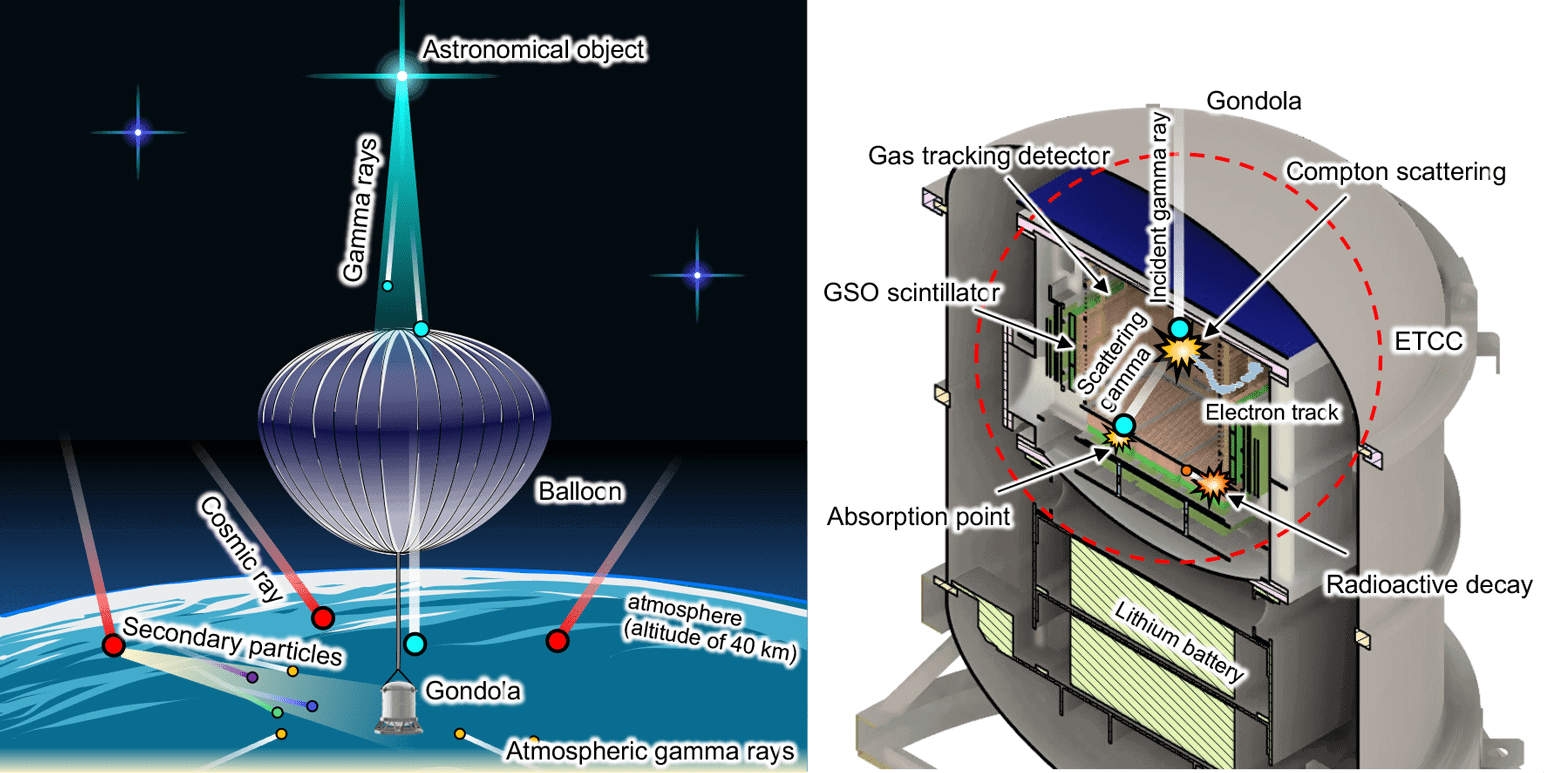Cosmic rays are high-energy particles from outer space, while gamma rays are electromagnetic radiation of high frequency. Cosmic rays originate from sources such as supernovae and black holes, while gamma rays are produced by radioactive decay and nuclear reactions.
Understanding the differences between cosmic rays and gamma rays is crucial for researchers studying high-energy phenomena in the universe. Cosmic rays consist of charged particles, like protons and atomic nuclei, that travel through space at nearly the speed of light.
On the other hand, gamma rays are a form of light without mass that can penetrate deeply into matter. Scientists use detectors and observatories to study cosmic rays and gamma rays, helping them unlock the mysteries of the cosmos and the fundamental forces of nature.
2. What Are Cosmic Rays?
Cosmic Rays Vs Gamma Rays: Exploring The Basics
When it comes to the mysterious realms of space, there are various phenomena that capture the imagination of astronomers and enthusiasts alike. One such intriguing topic is the comparison between cosmic rays and gamma rays. Let’s delve into the fundamentals of cosmic rays under the subheading:
2.1 Definition
Cosmic rays are high-energy charged particles that travel through space at incredibly high speeds.
2.2 Origin
These particles originate from various cosmic sources such as supernovae explosions and other high-energy processes in the universe.
2.3 Composition
The composition of cosmic rays includes protons, electrons, and atomic nuclei from different elements.

Credit: www.tasnimnews.com
3. What Are Gamma Rays?
3. What are Gamma Rays?
Gamma rays are a form of electromagnetic radiation. They are high-energy photons emitted by the nucleus of an atom during a nuclear reaction.
3.1 Definition
Gamma rays are electromagnetic waves with the shortest wavelength and highest frequency in the electromagnetic spectrum. They have no mass or charge, allowing them to penetrate deep into materials.
3.2 Properties
- High Energy: Gamma rays have the highest energy in the electromagnetic spectrum.
- Penetrating Power: They can penetrate through various materials, making them useful in medical imaging and radiation therapy.
- Speed: Gamma rays travel at the speed of light.
3.3 Sources
| Source | Description |
|---|---|
| Nuclear Reactions | Gamma rays are produced during radioactive decay and nuclear reactions. |
| Outer Space | Gamma rays are emitted by celestial objects such as pulsars and black holes. |
4. Differences Between Cosmic Rays And Gamma Rays
In the study of radiation, it is important to distinguish between cosmic rays and gamma rays. While they are both forms of high-energy radiation, cosmic rays and gamma rays differ in several key aspects.
4.1 Nature
Cosmic rays are energetic particles, such as protons and atomic nuclei, originating from outer space. They are primarily produced by powerful extraterrestrial events like supernovae explosions. On the other hand, gamma rays are electromagnetic waves with incredibly high frequencies and energies. They are generated by nuclear processes, radioactive decay, and even by extreme phenomena like black holes and pulsars. While cosmic rays are particles, gamma rays are pure energy in the form of photons.
4.2 Energy Levels
Cosmic rays possess extraordinary amounts of energy, ranging from millions to billions of electron volts (eV). In contrast, gamma rays have even higher energy levels, often surpassing billions of electron volts. These ultrahigh-energy gamma rays are among the most energetic radiation in the universe. Their immense energies allow them to travel vast distances through space.
4.3 Penetration Ability
When it comes to penetration ability, cosmic rays have an advantage over gamma rays. Cosmic rays can penetrate through the Earth’s atmosphere and reach the surface, posing a constant radiation hazard to astronauts and airline crew members flying at high altitudes. On the other hand, gamma rays are highly penetrating and can even pass through dense materials like lead and concrete. This ability allows gamma rays to be used in medical imaging and radiation therapy.
Overall, understanding the differences between cosmic rays and gamma rays is crucial in the field of radiation research. While cosmic rays are charged particles originating from space, gamma rays are high-energy electromagnetic waves. Cosmic rays possess immense energy levels, but gamma rays surpass them in terms of energy and penetration ability. These nuances highlight the unique characteristics of each type of radiation and their respective applications in science and technology.

Credit: www.nasa.gov
5. Similarities Between Cosmic Rays And Gamma Rays
5. Similarities Between Cosmic Rays and Gamma Rays
5.1 Electromagnetic Nature
Cosmic rays and gamma rays are similar in their electromagnetic nature, as both are forms of radiation that propagate through space as waves or particles.
5.2 Interaction With Matter
Both cosmic rays and gamma rays interact with matter, causing ionization and other nuclear processes when they collide with atoms in the material they encounter.
5.3 Astronomical Significance
The astronomical significance of both cosmic rays and gamma rays lies in their ability to provide crucial information about the universe, such as the nature of celestial sources and the processes that occur in extreme cosmic environments.
6. Detection And Measurement Techniques
Cosmic rays and gamma rays are high-energy particles and photons that originate from various sources in outer space. Detecting and measuring these particles and radiation are crucial for understanding their properties and interactions. This section explores the detection and measurement techniques used for cosmic rays and gamma rays, including the instruments and observatories employed for these purposes.
6.1 Cosmic Ray Detectors
Cosmic ray detectors are specialized instruments designed to register the arrival of high-energy particles originating from outer space. They come in various forms, including:
- Scintillation counters
- Cloud chambers
- Track detectors
6.2 Gamma Ray Detectors
Gamma ray detectors are essential for capturing and analyzing the high-energy electromagnetic radiation emitted by celestial sources. Common types of gamma ray detectors include:
- Scintillation detectors
- Compton cameras
- Pair production detectors
6.3 Observatories
Observatories play a vital role in cosmic ray and gamma ray research, providing long-term monitoring and data collection. These facilities utilize a range of instruments for detection and measurement, such as:
- Ground-based telescopes and detectors
- Space-based observatories and satellites
- Airborne detectors for atmospheric studies

Credit: www.science.org
7. Applications In Science And Technology
The applications of cosmic rays and gamma rays in science and technology are extensive and diverse. These high-energy particles and electromagnetic radiation have proven to be invaluable tools across various fields. In this section, we will explore some of the notable applications in medical imaging, environmental monitoring, and space exploration.
7.1 Medical Imaging
Cosmic rays and gamma rays are utilized in medical imaging techniques that help in diagnosing and treating various health conditions. One remarkable application is positron emission tomography (PET), which uses radioactive isotopes emitting gamma rays to create detailed three-dimensional images of internal organs and tissues. The ability to detect and visualize metabolic activity and biomarkers assists in early disease detection, cancer staging, and treatment monitoring.
7.2 Environmental Monitoring
The use of cosmic rays and gamma rays extends to environmental monitoring, aiding in the study of air and water quality, radiation levels, and environmental pollutants. For instance, detectors utilizing atmospheric muons (energetic cosmic rays) can measure the density and composition of the atmosphere, providing vital information about climate change and air pollution. Gamma ray spectroscopy is employed to analyze radioisotopes and their concentration in water, soil, and other environmental samples.
7.3 Space Exploration
Cosmic rays and gamma rays play a crucial role in furthering our understanding of the universe and enabling advancements in space exploration. Satellites and telescopes equipped with detectors for cosmic rays and gamma rays can capture valuable data about distant galaxies, black holes, pulsars, and cosmic phenomena. These measurements and observations help shed light on the origins and evolution of the universe and aid in planning future space missions.
8. Future Research And Discoveries
Cosmic Rays Vs Gamma Rays have long intrigued scientists with their unique properties and behaviors. As researchers delve deeper into these cosmic phenomena, exciting avenues for future research and discoveries emerge.
8.1 Advancements In Detection Techniques
Technological innovations are revolutionizing how we detect and analyze cosmic and gamma rays.
8.2 Understanding Cosmic-ray Origins
Exploring the origins of cosmic rays offers insights into the vast mysteries of the universe.
8.3 Unveiling Gamma-ray Burst Mysteries
Unraveling the enigmatic nature of gamma-ray bursts promises profound revelations in astrophysics.
Frequently Asked Questions For Cosmic Rays Vs Gamma Rays
What Are Cosmic Rays And Gamma Rays?
Cosmic rays are high-energy particles originating from outer space, while gamma rays are a form of electromagnetic radiation. Cosmic rays mainly consist of protons and atomic nuclei. Gamma rays are produced by the decay of unstable atomic nuclei and particle interactions.
What Are The Sources Of Cosmic Rays And Gamma Rays?
Cosmic rays are generated from phenomena such as supernovae, pulsars, and active galactic nuclei. Gamma rays originate from various sources including radioactive decay, supernova explosions, and interactions in accreting binary systems. Understanding these sources helps in studying the universe’s evolution.
How Do Cosmic Rays And Gamma Rays Affect Humans And Earth?
Cosmic rays and gamma rays can impact human health and Earth’s environment. High-energy cosmic rays can pose radiation hazards for astronauts and aircraft crew at high altitudes. Likewise, gamma rays from nuclear reactions can have detrimental effects if not controlled and contained properly.
Conclusion
Cosmic rays and gamma rays are both forms of high-energy radiation that originate from outer space. Although they share similarities in their origin and characteristics, they differ in their composition and behavior. Cosmic rays consist mainly of protons and atomic nuclei, while gamma rays are pure electromagnetic radiation.
Understanding the distinction between these two types of radiation is crucial in various fields of study, from astrophysics to medical imaging. By delving deeper into their properties, scientists can continue unraveling the mysteries of our vast universe.



